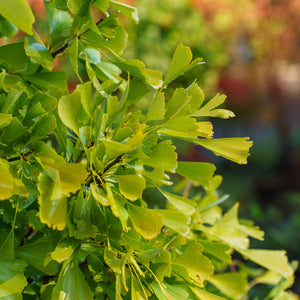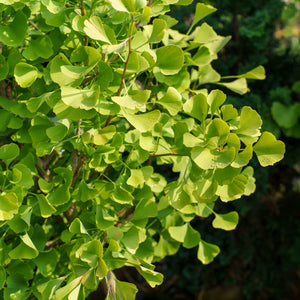The Ginkgo Guide
Ginkgo trees, with their unique beauty and ancient heritage, are a remarkable addition to any landscape. Renowned for their distinctive fan-shaped leaves, resilient nature, and striking presence, ginkgo trees bring a sense of timelessness and elegance to gardens and outdoor spaces. These remarkable trees possess a remarkable adaptability, thriving in diverse conditions when provided with appropriate care and attention. Whether you aspire to create a serene sanctuary reminiscent of ancient landscapes or seek a captivating centerpiece for your garden, ginkgo trees offer an exceptional choice.

About
Ginkgo trees, belonging to the Ginkgoaceae family, are a remarkable group of deciduous trees known for their captivating attributes and rich historical significance. With a lineage dating back millions of years, ginkgo trees are considered living fossils and are native to various regions across the globe, including China, Japan, and Korea. These exceptional trees possess distinct characteristics and play a crucial role in both cultural and ecological landscapes.
One of the striking features of ginkgo trees is their unique fan-shaped leaves, which turn a vibrant golden hue in the autumn, creating a breathtaking spectacle. Their leaves are resistant to pests and diseases, making them exceptionally durable and adding to their timeless appeal. Ginkgo trees also exhibit a fascinating dichotomy in their reproductive system, with separate male and female trees. The male trees produce cone-like structures known as catkins, while the female trees bear fruit-like structures containing edible seeds.
Ginkgo trees have long been revered for their cultural and medicinal significance. They hold a special place in many traditional practices and are often associated with longevity, resilience, and wisdom. Beyond their cultural importance, ginkgo trees provide numerous ecological benefits. They serve as valuable habitat and food sources for birds and other wildlife. Additionally, their leaves decompose slowly, enriching the soil and supporting a healthy ecosystem.
Adaptable and resilient, ginkgo trees can thrive in a range of soil types and climatic conditions. They prefer well-drained soil but can tolerate urban environments and pollution. Ginkgo trees exhibit excellent resistance to pests and diseases, further enhancing their appeal for landscaping projects. Their moderate growth rate and remarkable form make them ideal as standalone focal points, as well as components of mixed plantings or urban streetscapes.
Popular cultivars of ginkgo trees include 'Autumn Gold' and 'Princeton Sentry,' each offering unique characteristics and adding their own charm to any landscape. By selecting and caring for ginkgo trees, you not only enhance the beauty and visual interest of your outdoor space, but you also contribute to the preservation of a living relic and the environmental benefits it provides. Embrace the captivating allure of ginkgo trees and create a landscape that reflects both history and natural splendor.

Planting
Ginkgo trees have specific planting requirements that are crucial for their successful establishment and long-term growth. Here are some general guidelines to follow when planting and caring for ginkgo trees:
Soil: Ginkgo trees thrive in well-drained soil that is fertile and rich in organic matter. They can adapt to various soil types, including clay, loam, and sandy soil. Prior to planting, ensure the soil is loose and well-aerated. If needed, improve soil drainage and fertility by incorporating compost or organic matter.
Sunlight: Ginkgo trees prefer full sun exposure to thrive. Choose a planting location that receives at least six hours of direct sunlight each day. While they can tolerate partial shade, it's best to provide them with ample sunlight for optimal growth and foliage development.
Watering: Proper watering is crucial during the establishment phase of ginkgo trees. Water the tree deeply after planting and continue to provide regular irrigation throughout the first year. Water deeply and thoroughly, ensuring the moisture reaches the root system. Once established, ginkgo trees are generally drought-tolerant and require less frequent watering. However, during periods of extended dryness, it's important to water deeply to maintain adequate soil moisture.
Mulching: Apply a layer of organic mulch around the base of your ginkgo tree, leaving a few inches of space around the trunk. Mulching helps conserve soil moisture, regulate soil temperature, and suppress weed growth. Use wood chips, bark, or compost as mulch, and replenish it as needed to maintain a depth of 2-4 inches.
Pruning: Ginkgo trees typically have a naturally symmetrical shape and require minimal pruning. Remove any dead, damaged, or diseased branches as necessary. Prune during late winter or early spring, while the tree is still dormant, to encourage new growth and maintain a desired shape. Avoid excessive pruning, as ginkgo trees have a tendency to bleed sap.
By following these basic planting and care guidelines, you can ensure the successful establishment and healthy growth of your ginkgo trees. With their striking beauty and remarkable attributes, ginkgo trees will grace your landscape with elegance and charm for generations to come.

Care
Ginkgo trees require specific care to ensure their optimal growth and health. Here are some general guidelines for the care of ginkgo trees:
Watering: Ginkgo trees have moderate water needs. During the growing season, provide regular watering, aiming for about one inch of water per week. Adjust the frequency and amount based on rainfall and soil moisture levels. Water deeply and thoroughly to encourage deep root growth. In periods of drought or high temperatures, additional watering may be necessary to keep the soil adequately moist.
Pruning: Ginkgo trees generally require minimal pruning. However, it's recommended to remove any dead, damaged, or crossing branches to maintain a strong and balanced structure. Prune during late winter or early spring while the tree is still dormant, before new growth emerges. Use clean and sharp pruning tools to make precise cuts and promote proper healing.
Fertilizing: Ginkgo trees typically do not require heavy fertilization. However, you can apply a balanced, slow-release fertilizer in the spring or early summer to promote healthy growth. Follow the manufacturer's instructions regarding application rates and timing. Be cautious not to over-fertilize, as excessive nutrients can harm the tree. If uncertain, it's better to use less fertilizer than to overdo it.
Soil and Sunlight: Ginkgo trees are adaptable to various soil types but prefer well-drained soil. They can tolerate both full sun and partial shade, although they tend to thrive in areas with ample sunlight. Ensure the soil has good drainage to prevent waterlogging, as Ginkgo trees are sensitive to excessive moisture.
Pests and Diseases: Ginkgo trees are generally resistant to pests and diseases, making them a low-maintenance option. However, occasional issues such as aphids or leaf spot diseases may occur. Monitor the tree for any signs of pest infestation or disease symptoms. If necessary, treat the tree with appropriate insecticides or fungicides according to the instructions provided.
By following these basic care guidelines, your ginkgo trees will thrive and continue to display their majestic stature, elegant foliage, and timeless beauty in your landscape for years to come.

How To Use
Ginkgo trees offer versatility and can be used in various ways to enhance your landscape. Here are some recommendations based on their characteristics:
Focal Point: Ginkgo trees possess a unique and striking appearance, making them an ideal choice as a focal point in your landscape. Plant a single ginkgo tree to showcase its distinctive fan-shaped leaves and elegant form. It will be a captivating centerpiece that adds interest and beauty to your outdoor space.
Shade Tree: With their dense foliage and broad canopy, ginkgo trees provide excellent shade. Plant them strategically near outdoor seating areas, patios, or decks to create a cool and comfortable space where you can relax and enjoy the outdoors.
Windbreak: Ginkgo trees, known for their sturdy growth, can serve as an effective windbreak. Plant them in a row to create a windbreak that protects your garden or home from strong winds. Their dense foliage acts as a natural barrier, providing shelter and reducing the impact of wind.
Privacy Screen: Utilize the dense foliage and tall stature of ginkgo trees to create a natural privacy screen in your landscape. Plant them in a row along your property line to establish a visually appealing and functional barrier that enhances privacy and adds beauty to your surroundings.
Wildlife Habitat: Ginkgo trees attract various wildlife species, contributing to the biodiversity of your garden. Birds are particularly drawn to ginkgo trees, which provide them with shelter and a food source. By planting ginkgo trees, you can create a welcoming habitat for wildlife and enjoy the presence of birds and other creatures in your outdoor space.
Medicinal Benefits: Ginkgo trees, scientifically known as Ginkgo biloba, have been valued for their medicinal properties for centuries. The leaves of the ginkgo tree contain bioactive compounds that have been studied for their potential health benefits, including cognitive enhancement, improved blood circulation, antioxidant effects, and anti-inflammatory properties. Ginkgo extract is commonly used as a dietary supplement to support brain health and overall well-being.
When selecting ginkgo trees for your landscape, ensure they are planted in areas that receive full sun or partial shade and provide well-drained soil. With their unique foliage, functional benefits, and potential medicinal properties, ginkgo trees are a remarkable addition that will enhance the aesthetics and utility of your outdoor environment.
Conclusion
Ginkgo trees are a captivating and versatile addition to any landscape. Their unique appearance, fan-shaped leaves, and potential medicinal benefits make them a highly desirable choice for a variety of settings. By following proper planting and care practices, you can enjoy the beauty and advantages of ginkgo trees in numerous ways, whether it's creating a stunning focal point or providing shade and privacy in your garden. Ginkgo trees offer endless possibilities to enhance the aesthetics and functionality of your outdoor space. With dedication and care, you can create a remarkable landscape that will bring you joy and potentially contribute to your well-being for years to come.













